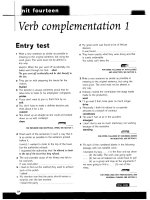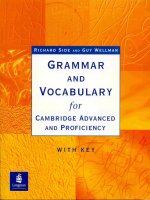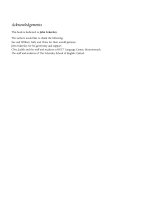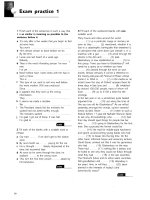Grammar and vocabulary games for children - part 1 potx
Bạn đang xem bản rút gọn của tài liệu. Xem và tải ngay bản đầy đủ của tài liệu tại đây (1.61 MB, 10 trang )
British Edition
British Edition
iœ ll
C opyright Y ear: 2007
Copyright N otice: t) 2007, Kathi W yldeck. A ll rights reserved.
ISBN : 978-1-84753-579-5
Edition: British
Printed in: The U nited States of Am erica
Publisher: Lulu.com
D edicated to m y grandparents,
E rnest and M arie Vines,
who gave m e a love and respect
for the English language.
A cknow ledeem ents
W ith m any thanks to M arcus Cremonese for designing the front cover of this book.
As an artist and m edical illustrator, he can be contacted through his website at
m .m edicalilluskation.com .au
Contents !lntroduction
Alphabet Sounds
N otm Types
Verb Types
Nouns, Verbs and Adjectives
Adverb Types
Case of Pronouns
Prepositions, Verbs and Pronouns
Conjunctions
Articles
Vocab Gam e //1
Vocab Gam e //2
Vow el Lengths
That Crazy ty ' Guy
Phonic Grid Relay
Simon Says
Know That N oun
W ho Am 1?
l W ent to the Shops and .
Adjective or Not?
V erb Triplets
Race of the Adverbs
Vocab Victors
Parts of Speech Bingo
Ready, Set, Take Y our Positions'!
A Trip to Town
Quarticles
Category Keyboard
Actverbs
Tick Tock
Person, Number, Gender, Case
Vocab Circle
W hat Did W e See?
Conjugation Noughts and Crossrs
Punctuation Panic!
Everyday Escapades
W hat's That W ord?
N oun W arfare!
Action Story
Guess the Proverb
W hat Type?
W ho Am 1?
How 's lt Done?
W hat's That?
Circular Story
Punctuation Relay
M other, Father and Baby
Clever Clogs
ln the M ood
Phrase or Clause?
Analyse That!
Gam es Resources
Other Books and W ebsite Activities
Introduction
This little book provides teachers and hom e-schooling parents with an
assortm ent of fun activities to help teach and practise gram m ar and vocabulary
skills.
M ost of the gam es are active and require plenty of space. The school hall, the
playground or other open area w ould be ideal.
At the end of a formal lesson, when children m ay be getting restless or losing
concentration, these learning activities w ill act as a reward for hard w ork, or for
keeping restless children's m inds active w hile, at the sam e tim e, allow ing them
to let off steam .
Several gam es are very useful for ESL teachers who m ay w ish to practise
vocabulary and listening com prehension w ith their ESL students. All of the
games require the children to listen and concentrate carefully on w ords and
instructions that the Gam es Leader calls out, and children who need practice
with follow ing instructions, and concentrating on a set task, will be strengthened
by these exercises.
If children do not have the know ledge required to play a particular gam e, then
the Games Leader (teacher or parent) can give a lesson on the topic before
starting the activity. By concentrating on the lesson, the children will be
rew arded w ith the fun of a gam e at the end of their efforts.
The directions for quite a few of the gam es in this book involve ççteam '' or
ttgroup'' play, but these instructions can be easily m odified for sm aller groups of
players. For home-schooling families of just two or three children, where the
directions for a game use the word ççteam'' or ttgroup'' just substitute the word
çtplayer'', so that instead of having, say, three team s competing against each
other in a race, you w ill have three players racing each other. In a relay where
each m ember of a team m ay nm once, ask the individual players in a sm all
group to nm tw o or three tim es instead. W ith m ost of the gam es in this book,
single players can also enjoy the activities with a parent, and instead of
competition between children, these single players can play the games just for
the sheer pleasure of having f'un and leam ing.
The second half of the book contains signs and answer sheets that w ill be
needed to play the gam es. Just photocopy the pages as required for the gam es
you choose to play.
The activities are suitable for children betw een the ages of seven and thirteen.
There are fifty games in all. Have fun and enjoy the book.
Game #1)
Alphabet Sounds
Give the children tw o or three letters of the alphabet to rem em ber, and ask them to
sit in a circle on the floor. Tell the players that you are going to say a w ord, and
that they m ust listen to see if the w ord starts with one of their letters. If it does,
they m ust get up, nm around the circle clockwise, and try to be the first to sit back
down in their place. The first one sitling down scores a point. 'l'he children should
keep their own scores and at the end of the gam e, see who the winner is. Exam ples
of words that could be called out are:
apple, ant, boy, bee, coat, cat, D avid, drum , egg, elephant, frog, fox, goat, girl, hen,
hill, ink, igloo, jug, Jack, koala, kite, lemon, lion, moon, mother, octopus, ox, pool,
pan, queen, quiet, rain, rabbit, snake, socks, train, tree, uncle, ugly, van, vase,
whale, w et, X -ray, xylophone, zoo, zebra.
Game #2)
N oun Typ es
Prepare three signs (from page 38 of the appendix), each with one of these words:
Com m on, Proper or Abstract. Stick them on three different w alls of the room and
point them out to the children. Tell the players that you are going to call out som e
nouns, and the children are to decide w hether the w ord is a com m on, proper or
abstract noun. A s soon as they know , they should run to the correct sign on the
wall. 'I'he first child to reach the correct sign wins a point. Children should keep
their own scores to find a w inning player at the end of the gam e. Possible
examples of w ords to use could be:
Com m on Pro er Abstract
Desk Jack Love
Chair M r. Brown Sadness
Ant Korea Hunger
Cup Dr. Sm ith H eat
D og Sydney Noise
Game #3)
Verb Tenses:
Sort the children into pairs and ask each pair to sit down on the floor
,
facing each
other, in a line w ith all the other pairs. Ask the players to stretch their legs straight
out w ith feet touching their partner's. Tell the players that once the gam e starts
,
it is
very important for them to keep their knees down and their legs still and straight
,
or
they m ight get trodden on. Give each pair of players a verb tense
,
either present,
past, perfect or future.
To play the game, read out a simple sentence, or even just say a verb in a
particular tense. The players representing that tense m ust get up and nm down to
the end of the line, stepping between each pair of legs as they go. Then they m ust
run behind their side of the line, back to the other end and then down between the
legs and back to their places. The first player to sit back in his place w ins a point
for his side of the line. Continue the gam e until everyone has nm tw o or three
tim es, and see which side of the line has scored the m ost points. Examples of
sentences to call out could include:
a) M ary loves her dad. (Present)
b) Peter goes to school. (Present)
c) David fell over. (Past)
d) Anna jumped onto the chair. (Past)
e) l will go to church on Sunday. (Future)
9 W e have written some stories. (Perfect)
g) John loolts happy. (Present)
h) Sam has ridden his bike to the shops. (Perfect)
i) Emma went to Jane's house. (Past)
j) Adam will fly his kite. (Future)
k) Ben has been to town. (Perfect)
Game ##)
Nouns, Verbs tt A4ectives:
Draw three big circles on the floor with chalk. Label one circle çlNoun'', another
one tçverb'' and the third one çiAdjective''. Tell the children that you are going to
say a word and they must decide if it is a noun, verb or adjective. As soon as they
have decided, they should run and stand inside the correct circle. T'hose who go to
the correct circle, and can tit inside it, are safe. Those who go to the wrong circle,
or w ho are too late to fit into the right one, are tr ead''. tr ead'' players should
stand next to the Gam es Leader and can help by taking t'urns to call out w ords from
the list. Keep playing until the circles can hold al1 the rem aining players. These are
the w inners. W ords for the list could include:
Noun Verb A d'ective
Cat Run Pretty
Tree Jum Soft
Girl Go Red
Jenny H ave Five
Tom ls Slow
Australia M ake Hot
N ew York D o Sad
M rs. Jones Sw im Happy
Pencil Sing Fast
Noise W ere Quiet
7
Game #5)
Adverb Types
Place the children into three groups and give each group a set of three signs
labelled çt-l-ime'' tçM anner'' and çtplace'' (from page 39 of the appendix). Sit the
children on the floor, in their groups, in front of you, and tell them that you are
going to say an adverb (or a sentence with an adverb in it). The players must
decide whether it is an A dverb of Tim e, M anner or Place, and quickly hold up the
correct sign. The first group showing the correct sign scores a point. Keep track of
team scores until there is an obvious winning group. Examples of adverb
sentences, w ith adverbs italicised are:
a) Today l turn nine. (Time)
b) Peter fell over. (Place)
c) You speak quickly. (M anner)
d) l will come home soon. (Time)
e) M rs. Evans talks quietly. (M anner)
9 James jumps high. (Place)
g) Get up and go outside. (Place)
h) Jack runs/as'/. (M anner)
i) Tomorrow is Monday. (Time)
j) Eat your dinner ntpw. (Time)
k) l looked down and saw a snake. (Place)
1) Peter talks loudly. tM annerl
Game #6)
Case ofpronouns:
This gam e is especially for ESL pupils. Give each child two signs, one saying
ttRight'' and the other saying çiW rong'' (gom page 40 of the appendix). Sit the
players on the floor in front of you and tell them that you are going to say som e
sentences containing pronouns. Som etim es the sentences w ill be right, and
som etim es one of the pronouns w ill be in the wrong case. The children must listen,
and then hold up one of their signs to show the Gam es Leader if the sentence w as
right or w rong. Correct answ ers score a point and each child can keep his own
score to find a winner. Examples of sentences could be:
a) John gave a book to her. (Right)
b) This is she 's shoe. (W rong)
c) That is mine. (Right)
d) Here is him toy. (W rong)
e) Her is a tall girl. (W rong)
9 They are coming home soon. (Right)
g) Them are his. (W rong)
h) I went with he. (W rong)
i) W endy gave us a present. (Right)
j) The pen is her. (W rong)
8
Game #7)
Prepositions, Verbs (f Pronouns
Draw three lines across the floor with chalk, so that the room is divided into thirds.
Nam e each third either tçprepositions'' tiverbs'' or ûipronouns''. Tell the children
that you are going to call out a w ord that w ill be either a preposition, a verb or a
pronoun, and that they m ust decide which one it is. A s soon as they know , they
should run and stand in the correct third of the room . The first child to reach the
correct place scores a point. Children can keep their own seores so that a winner
can be found at the end of the gam e. Exam ples of the selected parts of speech
could include:
Preposition V erb Pronoun
ln Sing 1
On Talk They
Under W alk Us
Dow n Am Him
W ith H as Their
To ls Ours
At Com e M ine
For Slee Y ou
Game #8)
Conjunctions:
Divide the
som e sheets of
pen and write the required w ords, another child as the <r isplayer'' to hold the sign
up for the Gam es Leader to see, and the rest of the children to be the ttThinkers''.
Tell the players that you are going to say som e sentences, each of which w ill
contain a conjunction. The Thinkers must think of the conjunction being used and
tell the W riter to write it down. The Displayer m ust then grab the sign and show it
clearly to the Gam es Leader. The first team with the correct sign displayed scores
a point. K eep score to select a winning team . Examples of sentences could include:
a. M ark ate a sausage and Jenny ate an apple.
Let thePZPG '
and give each group a m arker pen and
children in each team choose a ttW riter'' to hold the
b. l should com e but it is raining.
c. Jfyou go to the pool, l will be there.
d. Although it was dark, w e couldn't sleep.
e. D o your work until 1 tell you to stop.
f. Peterjumps higher than Sam does.
g. When you arrive, we will go out.
h. Kate w as sick so she w ent to bed.
children into three or four team s
i. Unless you have a w atch, you w ill be late.
j. W endy painted a picture because she likes painting.









